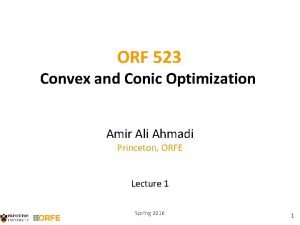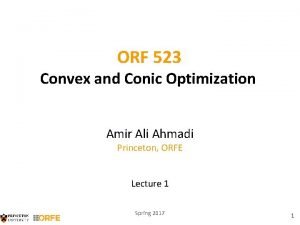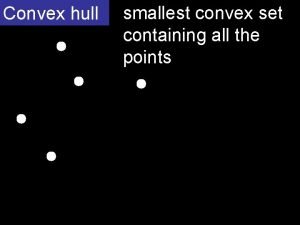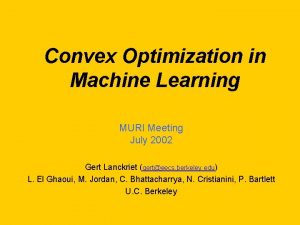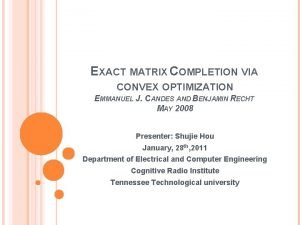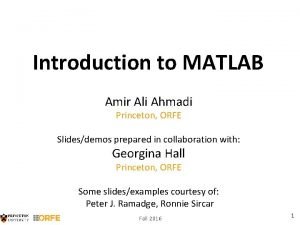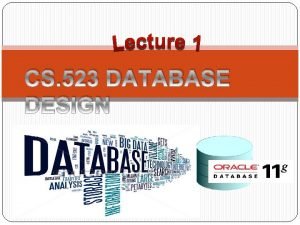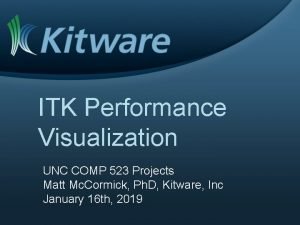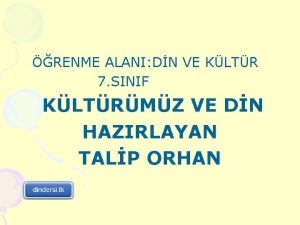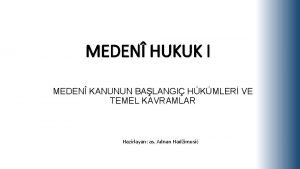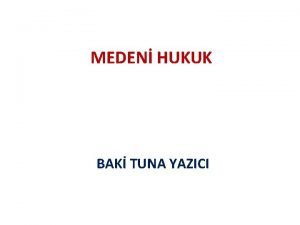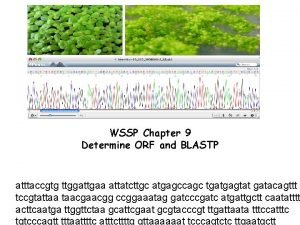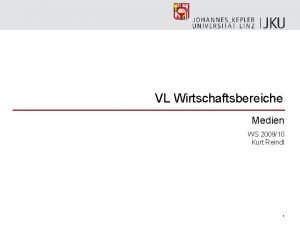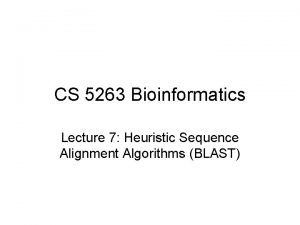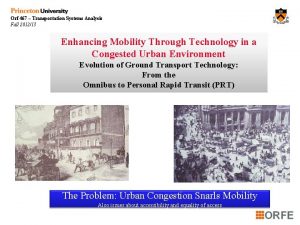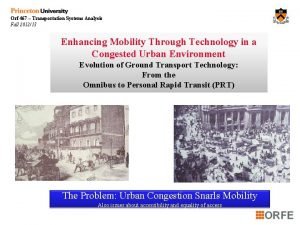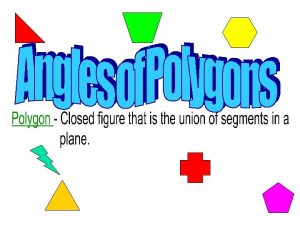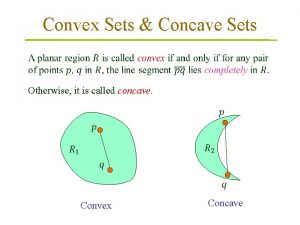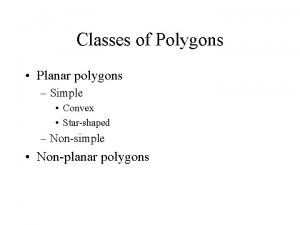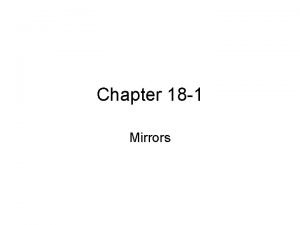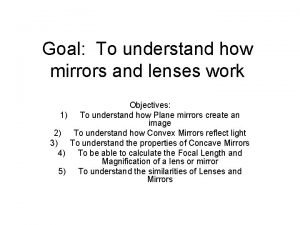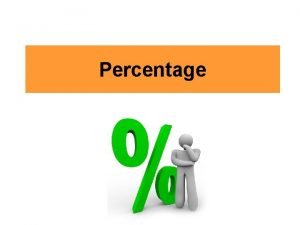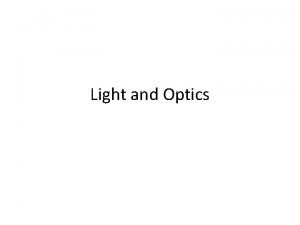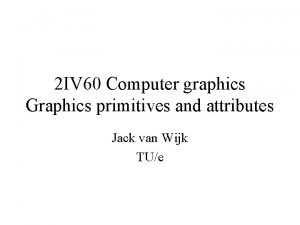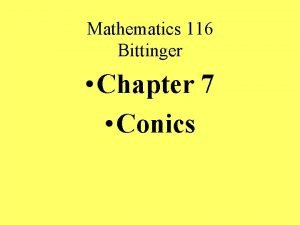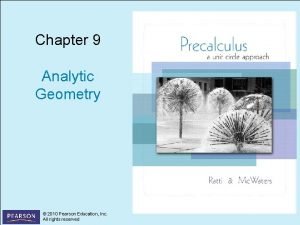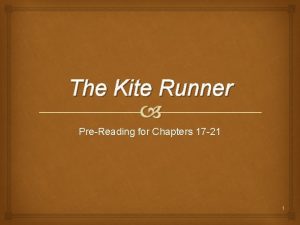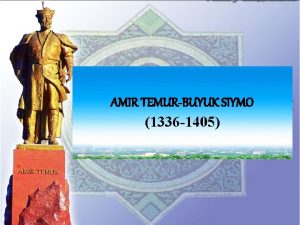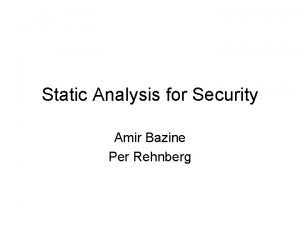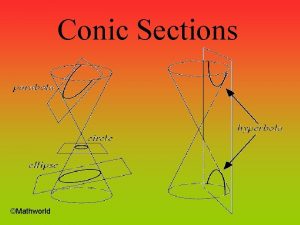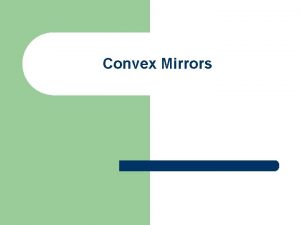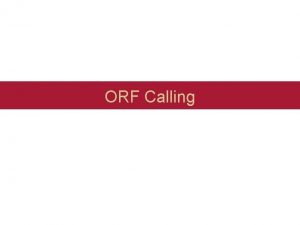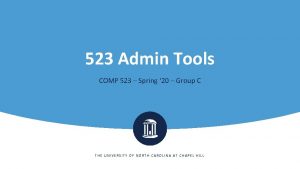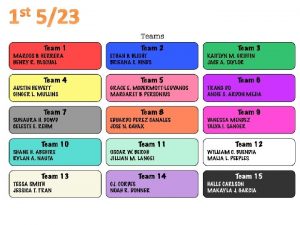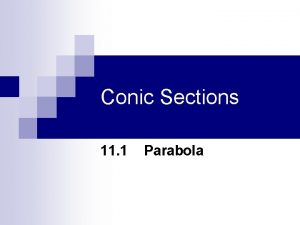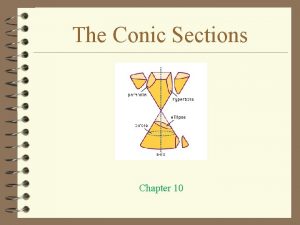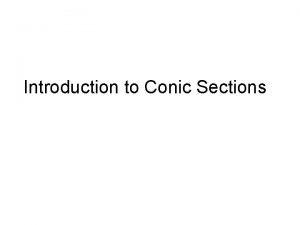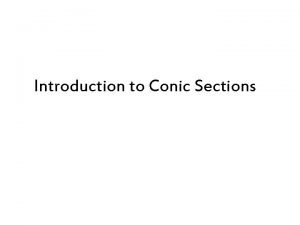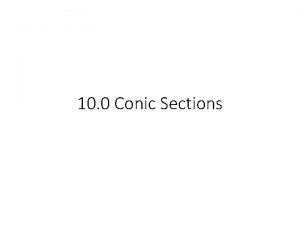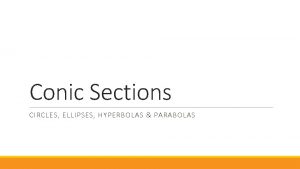ORF 523 Convex and Conic Optimization Amir Ali















































![Image credits and references - [DPV 08] S. Dasgupta, C. Papadimitriou, and U. Vazirani. Image credits and references - [DPV 08] S. Dasgupta, C. Papadimitriou, and U. Vazirani.](https://slidetodoc.com/presentation_image_h/cb24ff619c3be76ff6e78c45f13f705d/image-48.jpg)
- Slides: 48

ORF 523 Convex and Conic Optimization Amir Ali Ahmadi Princeton, ORFE Lecture 1 Spring 2016 1

What is this course about? §The mathematical and algorithmic theory of making optimal decisions subject to constraints. §Common theme of every optimization problem: §You make decisions and choose one of many alternatives. §You hope to maximize or minimize something (you have an objective). §You cannot make arbitrary decisions. Life puts constraints on you. § This pretty much encompasses everything that you do when you are awake. But let’s see a few concrete examples… 2

Examples of optimization problems In finance §In what proportions to invest in 500 stocks? §To maximize return. §To minimize risk. §No more than 1/5 of your money in any one stock. §Transactions costs < $70. §Return rate > 2%. In control engineering §How to drive an autonomous vehicle from A to B? §To minimize fuel consumption. §To minimize travel time. §Distance to closest obstacle > 2 meters. §Speed < 40 miles/hr. §Path needs to be smooth (no sudden changes in direction). 3

Examples of optimization problems In economics §How to play a strategic game? §To maximize payoff. §To maximize social welfare. §Be at a (Nash) equilibrium. §Randomize between no more than five strategies. In machine learning §How to assign likelihoods to emails being spam? §To minimize probability of a false positive. §To penalize overfitting on training set. §Probability of false negative <. 15. §Misclassification error on training set < 5%. 4

§So the question is not §Which problems are optimization problems? (The answer would be everything. ) §The right question is §Which optimization problems can we solve? §This is what this course is about. §We will formalize what we mean by “solve”. §We’ll see some of the most successful modern optimization tools available to solve a broad class of problems. §We will also see problems that we simply cannot solve. §Nevertheless, we’ll introduce strategies for dealing with them. §There will be many applications… 5

Prerequisites §Linear optimization (e. g. , at the level of ORF 522) §Familiarity with modeling, linear programming, and basic concepts of optimization. §Linear algebra §Multivariate calculus §Familiarity with MATLAB §Easy to pick up 6

Tentative list of topics §Optimality conditions in nonlinear programming §Convex analysis (a good dose) §Duality and infeasibility certificates §Computational complexity §Focus on complexity in numerical optimization §Conic programming §More in depth coverage of semidefinite programming §A module on combinatorial optimization §Selected topics: §Robust optimization §Interior point methods §Polynomial optimization §Sum of squares programming §Optimization in dynamical systems 7

Agenda for today §Meet your teaching staff & classmates §Get your hands dirty with algorithms §Game 1 §Game 2 §Course logistics and expectations 8

Meet your teaching staff §Amir Ali Ahmadi (Amir Ali, or Amirali, is my first name) §I am a relatively new Assistant Professor at ORFE. I come here from MIT, EECS, after a fellowship at IBM Research. §Office hours: Tuesdays, 6 -8 PM, Sherrerd 329. http: //aaa. princeton. edu/ a_a_a@p. . . §Meet your classmates! §Georgina Hall § Your name? §Grad student at ORFE § Department? §Office hours: Wed 5 -7, Sherrerd 322 § Maybe a bit of background? http: //scholar. princeton. edu/ghall gh 4@p. . . 9

Let’s get to the games! 10

Meet your fellow Princetonians! §The green check marks tell you when your visitors are available. §You want to meet as many of them as you can, for 15 minutes each. § 20 visitors, 20 time slots. How many can you meet? 11

§Let me start things off for you. Here is 15 meetings: §Can you do better? How much better? §You all get a copy of this Doodle on the handout. You have 8 minutes! 12

You tell me, I draw… 13

A good attempt § 18 meetings! §Can you do better? 14

An even better attempt § 19 meetings! §Can you do better? §How would you convince someone that it’s impossible to do better? 15

19 is the best possible! §Proof by magic: §Do you see what’s happening? 16

19 is the best possible! §There are 19 red arrows. §Each green checkmark “hits” at least one of them (by going either up or left). §If you could choose 20 green checkmarks, you would have to hit a red arrow twice. ▪ §And here is the magic: such a proof is always possible! 17

A related problem: shipping oil! Before we get to our second game, let’s look at another problem which may look more familiar to you. Image credit: [DPV 08] §Rules of the problem: §Cannot exceed capacity on the edges. §For each node, except for S ant T, flow in = flow out (i. e. , no storage). §Goal: ship as much oil as you can from S to T. 18

A couple of good attempts 19

13 is the best possible! §Proof by magic: §The rabbit is the red “cut”! §Any flow from S to T must cross the red curve. §So it can have value at most 13. §And here is the magic: such a proof is always possible! §What does any of this have to do with the Doodle problem? 20

From Doodle to Max-flow §The idea of reductions §They’ll come up often 21

A real-world instance of max-flow 22

§How long do you think an optimization solver would take (on my laptop) to find the best solution here? §How many lines of code do you think you have to write for it? §How would someone who hasn’t seen optimization approach this? §Trial and error? §Push a little flow here, a little there… §Do you think they are likely to find the best solution? §How would they certify it? 23

A bit of history behind this map §From a secret report by Harris and Ross (1955) written for the Air Force. §Railway network of the Western Soviet Union going to Eastern Europe. §Declassified in 1999. §Look at the min-cut on the map (called the “bottleneck”)! §There are 44 vertices, 105 edges, and the max flow is 163 K. §Harris and Ross gave a heuristic which happened to solve the problem optimally in this case. §Later that year (1955), the famous Ford-Fulkerson algorithm came out of the RAND corporation. The algorithm always finds the best solution (for rational edge costs). More on this history: [Sch 05] 24

Let’s look at our second problem …and tell me which one you thought was easier 25

Robust-to-noise communication §You are given a set of letters from an alphabet. §Want to use them for communication over a noisy channel. §Some letters look similar and can be confused at the receiving end because of noise. (Notion of similarity can be formalized; e. g. , think of Hamming distance. ) §Let’s draw a graph whose nodes are our letters. There is an edge between two nodes if and only if the letters can be confused. §We want to pick the maximum number of letters that we can safely use for communication (i. e. , no two should be prone to confusion). § What are we looking for in this graph? §The largest “stable set” (aka “independent set”)! 26

§Let me start things off for you. Here is a stable set of size 3: §Can you do better? How much better? §You all get a copy of this graph on the handout. § You have 8 minutes! 27

You tell me, I draw… 28

A couple of good attempts Size 4 §Can you do better? 29

A couple of good attempts Size 5 §Can you do better? 30

A couple of good attempts Size 5 §Tired of trying? §Is this the best possible? 31

5 is the best possible! §Proof by magic? §Unfortunately not §No magician in the world has pulled out such a rabbit to this day! (By this we mean a rabbit that would work on all graphs. ) §Of course there is always a proof: §Try all possible subsets of 6 nodes. §There are 924 of them. §Observe that none of them work. §But this is no magic. It impresses nobody. We want a “short” proof. (We will formalize what this means. ) Like the one in our Doodle/max-flow examples. §Let’s appreciate this further… 32

What our graph can look like with 32 letters §Maximum stable set anyone? ; ) §Is there a stable set of size 16? §Want to try all possibilities? There are over 600 million of them!! §If the graph had 100 nodes, there would be over 10 18 possibilities to try! 33

But there is some good news §Even though finding the best solution always may be too much to hope for, techniques from optimization (and in particular from the area of convex optimization) often allow us to find high-quality solutions with performance guarantees. §For example, an optimization algorithm may quickly find a stable set of size 15 for you. §You really want to know if 16 is impossible. Instead, another optimization algorithm (or sometimes the same one) tells you that 18 is impossible. §This is very useful information! You know you got 15, and no one can do better than 18. §We sill see a lot of convex optimization in this class! 34

A related problem: capacity of a graph 35

Capacity of a graph 36

Which of the two problems was harder for you? §Not always obvious. A lot of research in optimization and computer science goes into distinguishing the “tractable” problems from the “intractable” ones. §The two brain teasers actually just gave you a taste of the P vs. NP problem. (If you haven’t seen these concepts formally, that’s OK. You will soon. ) §The first problem we can solve efficiently (in “polynomial time”). §The second problem: no one knows. If you do, you literally get $1 M! § More importantly, your algorithm immediately translates to an efficient algorithm for thousands of other problems no one knows how to solve. 37

Modelling problems as a mathematical program 38

Let’s revisit our first game §What were your decision variables? §What were your constraints? §What was your objective function? 39

Let’s revisit our second game §What were your decision variables? §What were your constraints? §What was your objective function? 40

Why one hard and one easy? How can you tell? §Caution: just because we can write something as a mathematical program, it doesn’t mean we can solve it. 41

Fermat’s Last Theorem §Sure: And there are infinitely many more… §How about 42

Fermat’s Last Theorem 43

Fermat’s Last Theorem §Consider the following optimization problem (mathematical program): §Innocent-looking optimization problem: 4 variables, 5 constraints. §If you could show the optimal value is non-zero, you would prove Fermat’s conjecture! 44

Course objectives §The skills I hope you acquire: §Ability to view your own field through the lens of optimization and computation §To help you, we’ll draw basic applications from operations research, dynamical systems, finance, machine learning, engineering, … §Comfort with proofs in convex analysis. §Improved coding abilities (in MATLAB, CVX, YALMIP) §There will be a computational component on every homework (usually the fun part of the homework) §Ability to recognize hard and easy optimization problems. §Ability to rigorously show an optimization problem is hard. §Solid understanding of conic optimization, in particular semidefinite programming. §Familiarity with selected topics: robust optimization, polynomial optimization, optimization in dynamical systems, etc. 45

Software you need to download §Right away: MATLAB http: //www. princeton. edu/software/licenses/software/matlab/ §In the next couple of weeks (will likely appear on HW#2): CVX http: //cvxr. com/cvx/ §Towards the end of the course: YALMIP http: //users. isy. liu. se/johanl/yalmip/ 46

Course logistics §Course website: aaa. princeton. edu/orf 523 (should go live in a couple of days) §Your grade: § 50% homework (5 or 6 total – biweekly, can drop your lowest score, no extensions allowed) § Collaboration policy: you can and are encouraged. Turn in individual psets. Write the name of your collaborators. § 20 % Midterm exams (in class – 80 mins, a single double-sided page of cheatsheet allowed) § Exam 1: March 3 rd, Exam 2: in April, date TBA. Not cumulative. Can drop the lower score. § 30% Final exam/assignment (think of it as a longer, cumulative homework that needs to be done with no collaboration). In rare cases, may be replaced with a project. See syllabus. §Textbooks § What matters primarily is class notes. You are expected to take good notes. (I teach on the blackboard most of the time. ) Georgina will kindly provide lecture outlines. I will also occasionally post the notes that I use to prepare for lecture. § Four references will be posted on the course website if you want to read further – all should be free to download online. 47
![Image credits and references DPV 08 S Dasgupta C Papadimitriou and U Vazirani Image credits and references - [DPV 08] S. Dasgupta, C. Papadimitriou, and U. Vazirani.](https://slidetodoc.com/presentation_image_h/cb24ff619c3be76ff6e78c45f13f705d/image-48.jpg)
Image credits and references - [DPV 08] S. Dasgupta, C. Papadimitriou, and U. Vazirani. Algorithms. Mc. Graw Hill, 2008. - [Sch 05] A. Schrijver. On the history of combinatorial optimization (till 1960). In “Handbook of Discrete Optimization”, Elsevier, 2005. http: //homepages. cwi. nl/~lex/files/histco. pdf 48
 Orf 523
Orf 523 Orf 523
Orf 523 Concave vs convex shapes
Concave vs convex shapes Convex hull is the smallest convex set
Convex hull is the smallest convex set Convex optimization in machine learning javatpoint
Convex optimization in machine learning javatpoint Exact matrix completion via convex optimization
Exact matrix completion via convex optimization Convex optimization
Convex optimization Matlab princeton
Matlab princeton Stand like the brave
Stand like the brave Ba 523
Ba 523 Cs 523
Cs 523 My faith has found a resting place hymn
My faith has found a resting place hymn 523
523 Comp 523 unc
Comp 523 unc Dilimizdeki dini motifler
Dilimizdeki dini motifler örf adet hukuku örnekleri
örf adet hukuku örnekleri Baki tuna yazıcı
Baki tuna yazıcı Bioinformatics lecture
Bioinformatics lecture Codon defination
Codon defination Kurt reindl orf
Kurt reindl orf Get srf abroad
Get srf abroad Rti graph
Rti graph Orf finder
Orf finder Hassiba ben bouali university
Hassiba ben bouali university Lisa orf
Lisa orf Orf gene
Orf gene Orf transportation
Orf transportation Lisa orf
Lisa orf Orf transportation
Orf transportation Polygons definition
Polygons definition Convex and concave polygons
Convex and concave polygons Otot siliar
Otot siliar Graham scan
Graham scan Polygon convexity
Polygon convexity A flat, smooth mirror
A flat, smooth mirror Concave and convex mirror
Concave and convex mirror Difference between concave and convex quadrilateral
Difference between concave and convex quadrilateral Dual nature of light
Dual nature of light Filled area primitives in computer graphics
Filled area primitives in computer graphics Chapter 9 conic sections and analytic geometry
Chapter 9 conic sections and analytic geometry Chapter 7 conic sections and parametric equations
Chapter 7 conic sections and parametric equations Chapter 9 conic sections and analytic geometry
Chapter 9 conic sections and analytic geometry Where did pritilata fight
Where did pritilata fight Amir tokic
Amir tokic Amir abdala
Amir abdala Amir levinson
Amir levinson Sanaubar kite runner
Sanaubar kite runner Temur tuzuklari doc
Temur tuzuklari doc Amir bazine
Amir bazine
